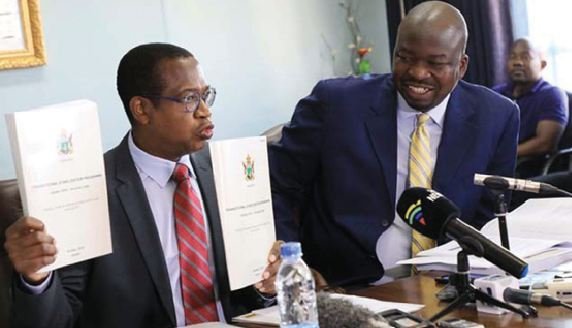Source: Ncube speaks on emotive 2% tax – The Zimbabwe Independent November 30, 2018
FINANCE minister Mthuli Ncube says Treasury will channel revenue collections from the 2% tax levied on electronic transactions towards the development of public infrastructure.
With recurrent expenditure gobbling up more than 90% of government revenues, the country has not made meaningful investment in public infrastructure.
According to official data, over the last 17 years government has spent a paltry US$180 million towards the maintenance and development of public infrastructure, but Ncube is upbeat that the unpopular tax will shore up government coffers to allow for meaningful investment towards infrastructure.
For 2018, government had a US$748 million budget for capital projects. The figure, according to Ncube, is set to increase to US$2,6 billion — US$1,1 billion coming from the budget and US$1,5 billion off budget.
Development partners are expected to contribute US$99,4 million of the off-budget financing which will be mostly targeted at energy, water, transport and irrigation, while statutory and public entities’ own resources will contribute US$390 million.
“Stakeholders continue to raise concern regarding the quality and pace of delivery of projects under the Public Sector Investments Programme. Providers of service blame the public sector for acquiring goods, works and services they cannot pay for, and in the process undermining their future viability,” according to Treasury’s Infrastructure Investment Plan.
“Furthermore, our projects are taking too long to consummate, cost more and take longer to be completed. Even where the project is ‘completed’, service delivery objectives are usually not met due to poor scoping at the time of commencement.”
Projects that have been given priority are the Harare-Beitbridge road, expansion of the Robert Mugabe International Airport, construction of Kunzvi Dam as well as Gwayi-Shangani Dam.
For the dualisation and upgrading of the Harare-Beitbridge road, Treasury will provide US$50 million which will be augmented by a US$250 million bond to be floated by the Zimbabwe National Roads Administration (Zinara).
“During 2019, an amount of US$910,4 million comprising of fiscal resources, US$381,3 million and Road Fund resources of US$272,8 million has been budgeted. Leveraging on the Road Fund, an amount of US$250 million will be mobilised from the market through a Zinara infrastructure bond to finance upgrade of the Harare-Beitbridge road”.
Construction of the Gwayi-Shangani Dam is already underway and Treasury has set aside US$35 million for its completion and feasibility for the conveyancing infrastructure.
An estimated US$350 million has been set aside for the expansion of Hwange Thermal Power Station through the addition of two 300-megawatt units, including associated transmission infrastructure.
An additional US$7 million in fiscal resources, and US$52,5 million of the Zimbabwe Power Company’s own resources have been ring-fenced to address some of the related costs of the project.
Furthermore, work will be undertaken to ensure financial closure for upgrading projects, such as Hwange Life Extension, Deka Pump Station, Bulawayo and Harare thermal power stations.
“The current access to power stands at 46%, with electrification rates for urban areas at 79%, whilst those of rural areas amount to 20%.
“In line with our commitment of ensuring that every household in Zimbabwe has one modern energy source of energy, grid extension projects will be up-scaled to cover some marginalised areas, including implementation of solar off-grid systems.
“Government (will) review all current licences, and introduce an auction system of all renewable projects, in order to introduce competiveness, as well as delivery of projects in the shortest possible time”.
According to the investment plan, spending into the road sector covers dualisation of 135km, upgrading of gravel roads to bituminous surfacing, regravelling of 483km of road and construction of 22 bridges countrywide.
Newer Post
January disease kills 50 000 cattle 
COMMENTS